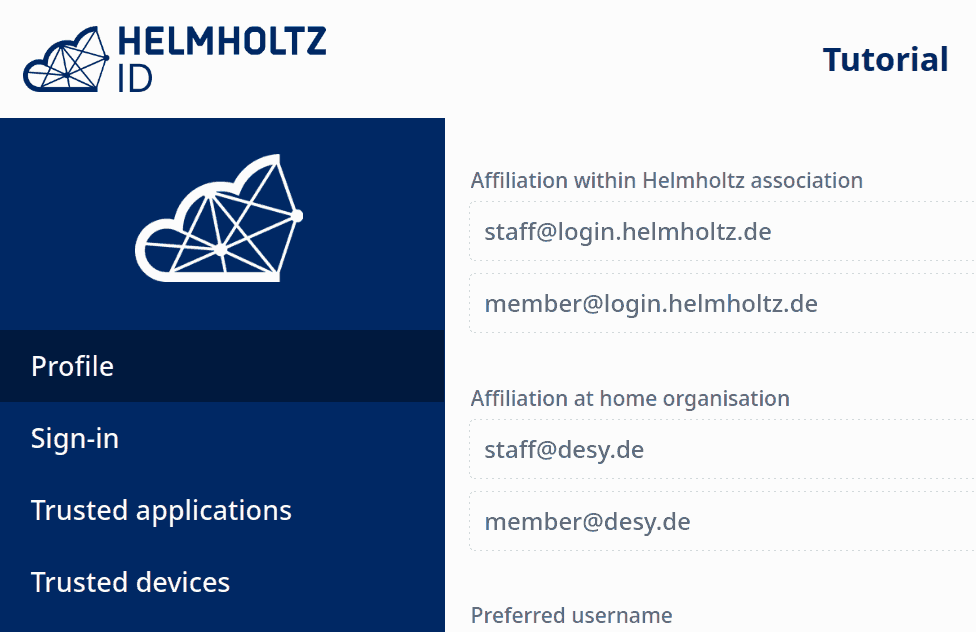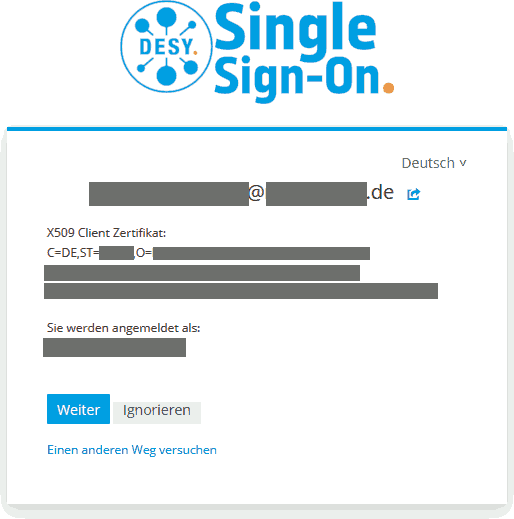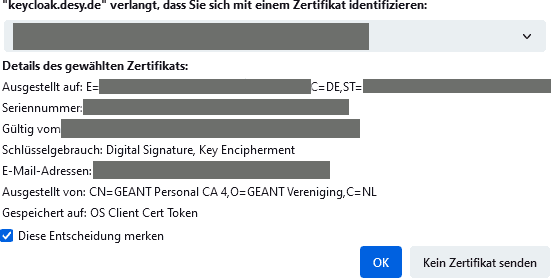Most frequently asked questions
I am from a Helmholtz Center. Can I use your services?
Mostly, yes. For Cloud Services, go to https://helmholtz.cloud/services. You can log in to most services via “Helmholtz ID”, select you own center, then use your own credentials. You can usually use them straight away, just try. In some cases, special conditions apply, please check the detailed description then. If anything’s not working as expected, contact us.
Important: All services may not be used for private or economic purposes as defined by EU state aid law: Helmholtz Cloud Terms of Use apply.
I am from a Helmholtz Center and want to give access to a colleague from outside Helmholtz. They can log in, but are denied access so far (“This service is for Helmholtz only”). How do I grant access?
You can request a “Virtual Organisation”, which allows you to self-manage users in groups and grant them access to most services. See here on how to proceed.
Some services (e.g. Sync&Share) allow you to share data via links for single shares. This is easy, but often unsafe and inconvenient to manage for larger groups and/or timescales.
I come from outside Helmholtz. Can I use your services?
Generally, no: Helmholtz resources must be used for Helmholtz purposes only. However, a Helmholtz colleague may share resources to you for project-specific purposes. See the previous point.
My student does not have access to the same services as me. Why is that?
It is probably because they are not directly employed by your (Helmholtz) center, but by their university instead. Access to our services is restricted to employees. Students, trainees and guests may be excluded. To verify a person’s status, you can check login.helmholtz.de:

Only persons with a staff@ or employee@ status are considered Helmholtz employees.
So what should you do? Please refer to the previous question on inviting external users.
Should I acknowledge HIFIS assistance in a publication? How?
Yes! Please include the following text:
We gratefully acknowledge the HIFIS (Helmholtz Federated IT Services [1]) team for … (e.g. support with the components above).
[…]
[1] Konrad, U., Huste, T., Jandt, U., & Schlauch, T. (2022, February 23). Helmholtz Federated IT Services: Innovative Cloud and Software Services for Science. Software Engineering 2022 (SE 2022). Zenodo. https://doi.org/10.5281/zenodo.15235978
I am missing service X / I propose to have service Y in HIFIS. What should I do?
Please contact us. In many cases, we already have solutions that might fit your purpose. In others, we collect service ideas and try to realize them in cooperation with Helmholtz Centers.
Do you offer training courses?
Yes, we have a portfolio of courses focusing on Research Software. See below or directly in our Course catalogue.
I need more details on technical or procedural things concerning HIFIS. Where do I find that?
Try https://hifis.net/doc. If you don’t find what you look for, contact us.
I want to stay updated on the progress of HIFIS. How?
We provide up-to-date information via frequent posts and newsletters. You are invited to subscribe!
Also check our timeline which is usually updated every spring.
Why are there several similar Helmholtz Cloud services like Jupyter or Nextcloud?
Some services offered by different centers are indeed based on the same software (e.g. Jupyter) or offer different tools for the same function (e.g. SciFlow and Collabtex). These alternatives are always welcome in the Helmholtz Cloud because they are good for scalability, resilience, and also for meeting individual needs as closely as possible.
A consequence of this choice is that we try to avoid generic names like “GitLab” or “chat” to be fair to future alternative services. Providers are therefore encouraged to find unique names, as you may have noticed for example with “Codebase” or “JuChat”.
We know this can be confusing, especially if the names are not self-explanatory. If you have an idea for a more elegant solution, let us know!
Login issues
I cannot find my institution in the list for Helmholtz ID login. What to do?
- You can filter for and use any of ORCID, Github, or Google to login.
- Your institution may decide to participate in eduGAIN. See here for more explanations. Once joined, your institution will appear in our list.
I accidentally refused to transfer my personal data when trying to log in to a service, and made that decision permanent. Now I cannot use it. How to revert that?
- Go to https://login.helmholtz.de/home.
- Log in, if needed.
- On the account page, click on the Trusted Application tab.
- Scroll down to the section Applications with access denied.
- Select the service of interest, click on Unblock access and confirm if necessary.
I cannot login via Helmholtz ID / cannot join a group (VO) due to errors like “connection lost”.
Often this occurs after previous multiple and/or incomplete login attempts. The login attempt should be restarted cleanly:
- Close all tabs / browser windows that may have an aborted / incomplete login session.
- Flush browser cache.
- Log in to https://login.helmholtz.de/home/ -> select your institution, or Github, ORCID, Google.
- Optional: you can leave the tab open.
- Go to the service you need and log in there (via Helmholtz ID). You should not be asked again for your login data due to the Single-Sign On functionality and the still open login session from the previous steps.
While logging in using my home organisation, I got an Authentication failed error.
The error message says:
The remote authentication was successful, however the the server’s policy requires more information then was provided to register your account.
Your home organisation did not release all mandatory information to create your Helmholtz ID account. Beside the federations metadata, the mandatory information that your organisation needs to transfer to the Helmholtz ID can be reviewed in the documentation. Please contact your organisation’s helpdesk and ask to release the mandatory information to the Helmholtz ID. In case your home organisation does not want to release this information, you can use some social accounts like Google, GitHub and ORCID.
I lost my password to access your service X. How can I reset it?
We do not deal with passwords. You should always log in with Helmholtz ID and your own center’s credentials. If the error persists, ask your local IT.
When trying to log in to a DESY Service, I am asked for a certificate (X509 or similar). I don’t have any and wonder why I am asked. Can I log in anyway?

We normally do not enforce login with any such certificate. So it is likely that something in your browser’s configuration enforces it. In some cases, you can just skip it via clicking “ignore”. For firefox browsers, you can try (should work similarly with other browsers):
- Open “Settings” in Firefox via the “hamburger menu”.
- Then select “Privacy & Security”.
- Scroll to the Certificates section (quite far down), and choose “View Certificates…”.
- Now select the tab “Authentication Decision”.
- There, an entry for the host keycloak.desy.de will appear; delete this entry.
- We are almost there: During the next new login to syncandshare.desy.de with Firefox, a dialog window will appear in Firefox (see below). In this dialog, select “Remember this decision” and click Don’t Send Certificate.

Training workshops
Which workshops does HIFIS offer?
You can find an overview of all ready-to-go workshops in the list of published materials. These are offered on a regular basis. For some topics, there is already some self-learning material, more is in preparation.
We also may offer custom-tailored versions of these workshops on demand or create workshops on other RSE topics.
Anybody within Helmholtz may request a workshop as long as they can bring around 15 to 20 participants. If you would like us to host a specific workshop for your team, please contact us: support@hifis.net.
You can either choose from the list of workshop topics or request a custom workshop. We will reach out to you to clarify the details based on your individual case.
For members of the Helmholtz Association, requesting and participating in HIFIS workshops is free of charge. We reserve the option to charge for participants who are not part of the Helmholtz Association (although we usually prefer not to).
Can I use your workshop materials for my own workshop?
By default, our workshop materials are published under the Creatice Commons license CC BY 4.0. This means you can share (copy and redistribute) the material, but also adapt it to your needs under the provision that you attribute the authors with appropriate credits.
Deviations from this policy may occur. Please check the footer of the workshop materials for information on the license that applies.
Do you help me with teaching my workshop, do you offer something like “train the trainer”?
At the moment, we don’t have the possibility to do any instructor trainings. This may change in the future. However, we will be happy to lend you advisory support as much as we can and to welcome you at our annual TEACH conference for teaching enthusiasts across Helmholtz. We advertise these in our blog post.
HIFIS Tips
Here we gather together a few tips that we are frequently asked about.
Contact us
You have a question that isn’t answered here? Or you do have feedback on the FAQ?
Contact us anytime in English or German / Deutsch: support@hifis.net


